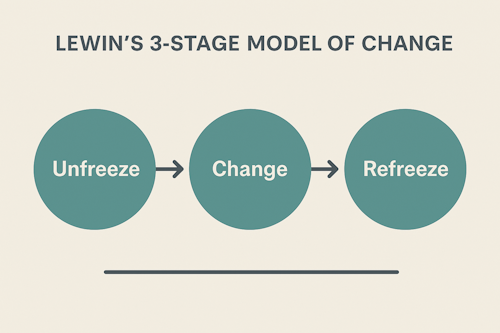Lewin's 3 Stage Theory of Change
Classic unfreeze-change-refreeze pattern.
"A successful change involves moving from a known to an unknown. The first requirement is to unfreeze the present level." 1

Change is a constant force in Agile environments. Teams evolve, processes improve, and organizations adapt to shifting market demands. One of the foundational models for understanding organizational change is Kurt Lewin's 3-Stage Model, which frames change as a process of unfreezing, changing, and refreezing. Though developed in the mid-20th century, Lewin's model remains highly relevant for Agile teams navigating transitions in mindset, structure, or delivery approach. Understanding this model helps coaches guide teams more effectively through transformation, resistance, and adaptation.
Lewin's 3 Stages and Their Impact on Agile Organizations
- Unfreeze:
In this stage, the organization or team recognizes the need for change. This involves challenging the status quo and preparing people to move away from existing habits. For Agile teams, this often means recognizing that traditional ways of working (e.g., heavy upfront planning, siloed roles) are no longer effective. The emotional tone may involve discomfort, uncertainty, or skepticism.
- Change:
Here, new behaviors, processes, and beliefs are introduced. Agile ceremonies, cross-functional collaboration, and iterative delivery replace old patterns. This stage can feel chaotic as team members experiment and learn. It's critical that leadership and coaches provide guidance, psychological safety, and clarity.
- Refreeze:
Once the new way of working begins to stabilize and show value, teams enter the refreezing stage. Practices become normalized. Agile values and principles are internalized. Continuous improvement can now emerge from a new baseline. The goal is not rigid preservation, but a dynamic stability that supports future adaptation.
Lewin's model sheds light on why Agile transformations often stall, teams may leap into "change" without adequately unfreezing outdated mindsets or prematurely refreeze before new behaviors solidify. Without coaching support, teams may revert under pressure to old habits. The model also helps Agile leaders time their interventions more effectively and understand where resistance is rooted.
Scenario
A traditional software team is being asked to adopt Scrum. Initially, they agree to Daily Scrums and Sprints, but continue using Waterfall habits underneath. Meetings feel superficial, and there's frustration with the Scrum Master.
- Unfreeze: The team must first understand why Agile is needed. A coach may conduct Retrospectives focused on delivery pain points and highlight customer delays.
- Change: With support, the team begins adopting story mapping, refining their Definition of Done, and working in smaller slices. Mistakes are discussed openly.
- Refreeze: After several iterations, Daily Scrums become more valuable, collaboration tightens, and velocity becomes predictable. The team can now focus on continuous improvement rather than basic mechanics.
Ways to Mitigate Challenges:
- During Unfreeze:
- Use data, stories, and real pain points to show the need for change.
- Engage stakeholders in identifying constraints.
- Cultivate a sense of urgency without panic.
- During Change:
- Provide just-in-time training and coaching.
- Create space for learning and experimentation.
- Normalize failure as part of the transition process.
- During Refreeze:
- Celebrate wins to reinforce new norms.
- Align performance reviews and KPIs with Agile values.
- Guard against regression by keeping Retrospectives active and focused.
Conclusion:
Lewin's model offers Agile coaches a timeless lens to interpret the emotional and behavioral waves teams experience during transformation. When combined with Agile values, it becomes a powerful tool to help teams move not just faster, but with clarity and resilience. The real strength of the model lies in its simplicity and universal truth: meaningful change is a process, not an event.
Key Takeaways
- Unfreeze: Prepare for change by addressing beliefs and creating psychological readiness.
- Change: Guide teams through new behaviors with support, patience, and clarity.
- Refreeze: Anchor new norms while remaining open to future evolution.
Summary
Lewin's 3-Stage Theory: unfreeze, change, refreeze - provides a clear and psychologically grounded roadmap for Agile transformation. It reminds us that before we introduce Agile practices, we must loosen old assumptions. As new behaviors emerge, we must support teams through the disorientation of transition. And once improvement takes root, we must stabilize and reinforce the gains without becoming rigid. By respecting each phase, Agile coaches can guide lasting change that sticks.